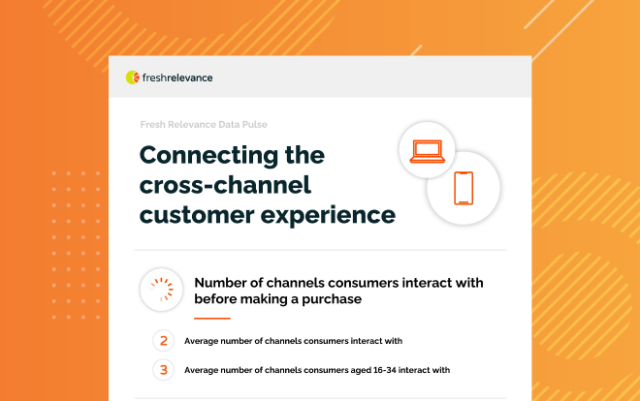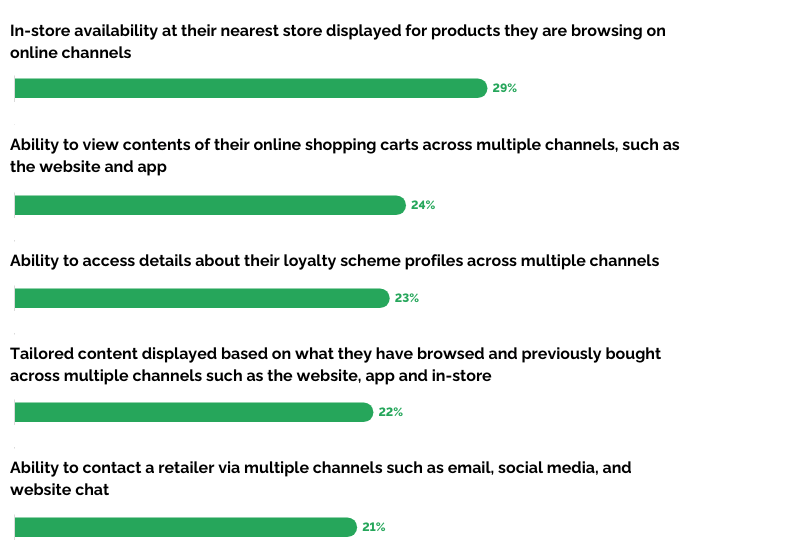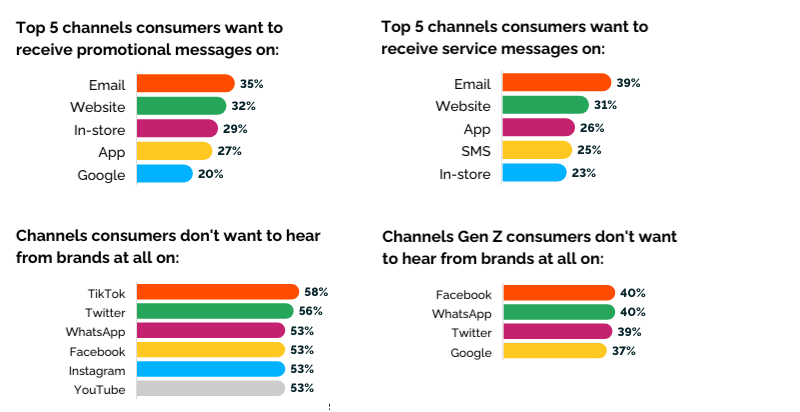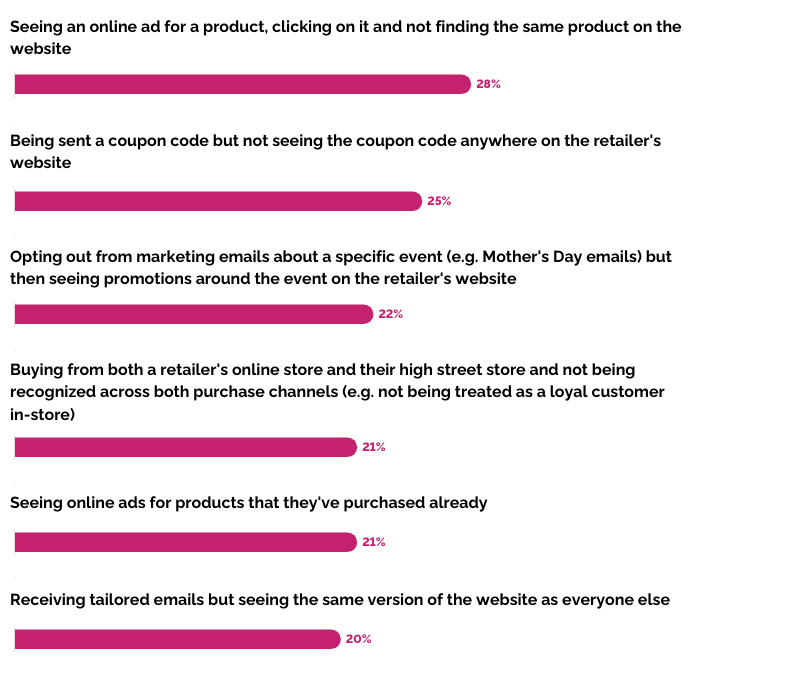Connecting the cross-channel customer experience

More and more, consumers interact with eCommerce brands on a multi-channel basis, switching instinctively between emails, mobile apps, bricks-and-mortar, social media and websites. In fact, Forrester research shows that consumers use more than four devices each day. And whilst many marketers think about channels separately, consumers expect a single cohesive experience that transcends channels.
So it’s important for businesses to connect the dots between their channels to provide customers with a consistent and tailored customer experience.
Together with Censuswide, we polled 2000 consumers across the UK to find out how many channels shoppers interact with before making a purchase, how different channels fit into the customer journey and what consumers want to see from a cross-channel customer experience.
Key takeaways:
- Getting the cross-channel customer experience right should be a key priority for retailers, with 63% of consumers saying they interact with at least 2 channels before making a purchase.
- Consumers want their relationship with a retailer to be acknowledged across channels, for example almost 1 in 4 consumers want to be able to access details of their loyalty scheme across multiple channels and 20% of consumers find it frustrating when a retailer sends them tailored emails but shows them the same website as everyone else.
- Bridging the gap between online and in-store is important to consumers, with more than 1 in 4 consumers (29%) saying they are more likely to shop with a retailer that shows them in-store availability at their nearest store for products they are browsing on online channels and 21% of respondents getting frustrated when they buy from both a retailer’s online and physical stores and aren’t recognized across both purchase channels.
- Convenience is a key criteria for a good cross-channel customer experience. For example, 1 in 4 consumers are more likely to shop with a retailer when they can view the contents of their online shopping cart across multiple channels and find it frustrating when a retailer sends them a coupon code but doesn’t show them the code anywhere on their website.
- Gen Z and Millennial consumers are more demanding when it comes to retailers delivering a cross-channel customer experience and also interact with more channels before making a purchase than older consumers.
- Email comes out on top as the channel most consumers want to hear from retailers on.
Number of channels consumers interact with before making a purchase

Over half of consumers (63%) interact with at least 2 channels before making a purchase, so getting the cross-channel experience right should be a key priority for retailers. We will delve into specific cross-channel tactics that consumers want to see in the next sections.
The data also reveals that Gen Z and Millennial consumers interact with more channels, with 1 in 3 consumers aged 16-34 typically interacting with 3 channels before making a purchase.
What consumers want from a cross-channel customer experience

Consumers are more likely to shop with retailers who offer a seamless, tailored and convenient cross-channel experience.
Bridging the gap between online and in-store is important, since more than 1 in 4 consumers (29%) are more likely to shop with a retailer that shows them in-store availability at their nearest store for products they are browsing on online channels. This means it’s important to have geotargeting functionality in place.
Learn more: The Ultimate Geotargeting Lookbook
Almost 1 in 4 consumers (24%) are more likely to shop with a retailer when they can view the contents of their online shopping cart across multiple channels, such as the website and app. This number is higher for Gen Z consumers, with almost 1 in 3 (32%) selecting this option. Businesses can implement a cross-channel cart widget to help shoppers see their cart and complete their purchase across multiple channels.
Cross-channel loyalty schemes are another important consideration, with almost 1 in 4 consumers (23%) saying they are more likely to shop with a retailer when they can access details about their loyalty scheme profile (such as how many loyalty points they have) across channels such as the retailer’s website, app and in-store.
It’s no secret that consumers want a personalized experience, but it’s no good only personalizing the experience based on data from one channel. 22% of consumers are more likely to shop with a retailer that shows them tailored content such as product recommendations based on what they have browsed and bought previously across multiple channels, for example the website, app and in-store. Almost 1 in 3 consumers aged 16-34 selected this option, making this an even more important consideration if your target audience is this age group.
Finally, 21% of consumers are more likely to shop with a retailer who they can contact via multiple channels, such as email, social media and website chat, so it’s important to make it as easy as possible for your shoppers to reach a member of your team.
Consumer frustrations

Delivering a convenient and tailored cross-channel customer experience isn’t simply a nice to have; not providing one can be a source of frustration for consumers.
Once again, convenience is key, with 1 in 4 consumers (25%) finding it frustrating when a retailer sends them a coupon code but doesn’t show them the code anywhere on their website, meaning they have to find the email and copy and paste the code on the website when they make their next purchase. Almost 1 in 3 Gen Z consumers (30%) find this frustrating.
More than 1 in 4 consumers (28%) find it frustrating when they see an online ad for a product, click on it and can’t find the product they’re interested in on the website the ad takes them to. What’s more, 21% of consumers find it frustrating when a retailer shows them online ads for products that they’ve purchased already. Behavioral targeting is an effective way to avoid this. Tools such as Fresh Relevance’s segment builder let you create behavioral segments based on customers’ activity. Once a segment is created in Fresh Relevance, that list of contacts can be exported and used to retarget customers in your ad campaigns. For example, you could create a segment of shoppers who have browsed a particular product but haven’t bought it.
For consumers, the cross-channel experience is also about taking the option to opt-out of event-specific marketing beyond email, with 22% of consumers finding it frustrating when they opt out of marketing emails about a specific event, such as Mother’s Day, but the online retailer then shows them promotions around the event when they visit the website. Tools such as Fresh Relevance’s Experience Management empower businesses to tailor the entire customer journey throughout their site for customers who have opted out of receiving emails about particular events.
Learn more: How to take your opt-out experience beyond email
Recognition of their relationship with a brand is also important to consumers, with 21% of respondents saying they find it frustrating when they buy from both a retailer’s online and physical store and aren’t recognized across both purchase channels (for example, the retailer doesn’t treat them as a loyal customer in-store). More than 1 in 4 consumers aged 16-34 find this frustrating.
Similarly, 20% of consumers find it frustrating when a retailer sends them tailored emails but shows them the same website as everyone else. Again, this is a greater concern for younger consumers, with more than 1 in 4 Gen Z consumers (26%) finding this frustrating. A personalization tool such as Fresh Relevance makes it easy to provide a consistent cross-channel experience and align relevant, real-time content across the website, email and more.
Channels consumers want (and don’t want) to hear from retailers on

Email remains the most popular channel for receiving promotional messages (for example, information about sales and new products) and service messages (for example, order updates). This is true for all age groups, showing that newer channels such as social media haven’t managed to replace email.
Gen Z are generally more open towards receiving brand content across all channels than their older counterparts. Older age groups in particular don’t want to hear from brands at all on TikTok and Twitter, perhaps simply because they’re not as active on these channels as younger consumers.
Download the infographic to view and save all the data visualizations shown here in one place.
Copyright © Fresh Relevance. You are welcome to reuse this data on public websites, provided it is attributed to Fresh Relevance and has a link to this page, for example: Data from Fresh Relevance Ltd.

